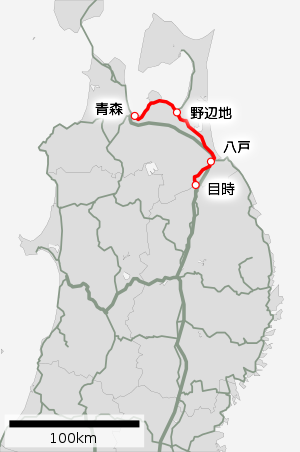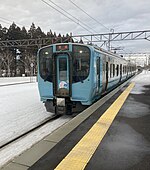Aoimori Railway Line
Railway line in Aomori prefecture, Japan From Wikipedia, the free encyclopedia
The Aoimori Railway Line (青い森鉄道線, Aoimori Tetsudō-sen) is a regional rail line in Aomori Prefecture, Japan that is operated by the Aoimori Railway Company. It connects the terminal station of the Iwate Galaxy Railway Line, Metoki Station, in the town of Sannohe to Aomori Station, the terminus of several rail lines in the city of Aomori. The Aoimori and Iwate Galaxy Railway Lines are former sections of the Tōhoku Main Line that connected Tokyo to Aomori that were rendered obsolete for long-distance passenger services by the completion of the high-speed Tōhoku Shinkansen between Tokyo and Shin-Aomori stations. Though local passenger services are run on the line by the Aoimori Railway Company, the East Japan Railway Company continues to operate limited services, such as the sightseeing train Resort Asunaro, along the line, and the Japan Freight Railway Company (which owns a minority stake on the Aoimori Railway Company) transports freight along the line.
| Aoimori Railway Line | |||
|---|---|---|---|
 Aoimori Railway 701 series EMU in September 2010 | |||
| Overview | |||
| Owner | Aomori Prefecture | ||
| Locale | Aomori Prefecture, Japan | ||
| Termini | |||
| Stations | 26 | ||
| Service | |||
| Type | Regional rail | ||
| Operator(s) | Aoimori Railway | ||
| Rolling stock | Aoimori 701 series EMUs Aoimori 703 series EMUs | ||
| History | |||
| Opened | 1 September 1891 (As part of the Nippon Railway) 1 December 2002 (As the Aoimori Railway Line between Metoki and Hachinohe) 4 December 2010 (As the Aoimori Railway Line between Hachinohe and Aomori) | ||
| Technical | |||
| Line length | 121.9 km (75.7 mi) | ||
| Track gauge | 1,067 mm (3 ft 6 in) | ||
| Electrification | 20 kV AC, 50 Hz overhead catenary | ||
| |||
Aoimori Railway Line | ||||||||||||||||||||||||||||||||||||||||||||||||||||||||||||||||||||||||||||||||||||||||||||||||||||||||||||||||||||||||||||||||||||||||||||||||||||||||||||||||||||||||||||||||||||||||||||||||||||||||||||||||||||||||||||||||||||||||||||||||||||||||||||||||||||||||||||||||||||||||||||||||||||||||||||||||||||||||||||||||||||||||||||||||||||||||||||||||||||||||||||||||||||||||||||||||||||||||||||||||||||||||||||||||||||||||||||||||||||||||||||||||||||||||||||||||||
|---|---|---|---|---|---|---|---|---|---|---|---|---|---|---|---|---|---|---|---|---|---|---|---|---|---|---|---|---|---|---|---|---|---|---|---|---|---|---|---|---|---|---|---|---|---|---|---|---|---|---|---|---|---|---|---|---|---|---|---|---|---|---|---|---|---|---|---|---|---|---|---|---|---|---|---|---|---|---|---|---|---|---|---|---|---|---|---|---|---|---|---|---|---|---|---|---|---|---|---|---|---|---|---|---|---|---|---|---|---|---|---|---|---|---|---|---|---|---|---|---|---|---|---|---|---|---|---|---|---|---|---|---|---|---|---|---|---|---|---|---|---|---|---|---|---|---|---|---|---|---|---|---|---|---|---|---|---|---|---|---|---|---|---|---|---|---|---|---|---|---|---|---|---|---|---|---|---|---|---|---|---|---|---|---|---|---|---|---|---|---|---|---|---|---|---|---|---|---|---|---|---|---|---|---|---|---|---|---|---|---|---|---|---|---|---|---|---|---|---|---|---|---|---|---|---|---|---|---|---|---|---|---|---|---|---|---|---|---|---|---|---|---|---|---|---|---|---|---|---|---|---|---|---|---|---|---|---|---|---|---|---|---|---|---|---|---|---|---|---|---|---|---|---|---|---|---|---|---|---|---|---|---|---|---|---|---|---|---|---|---|---|---|---|---|---|---|---|---|---|---|---|---|---|---|---|---|---|---|---|---|---|---|---|---|---|---|---|---|---|---|---|---|---|---|---|---|---|---|---|---|---|---|---|---|---|---|---|---|---|---|---|---|---|---|---|---|---|---|---|---|---|---|---|---|---|---|---|---|---|---|---|---|---|---|---|---|---|---|---|---|---|---|---|---|---|---|---|---|---|---|---|---|---|---|---|---|---|---|---|---|---|---|---|---|---|---|---|---|---|---|---|---|---|---|---|---|---|---|---|---|---|---|---|---|---|---|---|---|---|---|---|---|---|---|---|---|---|---|---|---|---|---|---|---|---|---|---|---|---|---|---|---|---|---|---|---|---|---|---|---|---|---|---|---|---|---|---|---|---|---|---|---|---|---|---|---|
| ||||||||||||||||||||||||||||||||||||||||||||||||||||||||||||||||||||||||||||||||||||||||||||||||||||||||||||||||||||||||||||||||||||||||||||||||||||||||||||||||||||||||||||||||||||||||||||||||||||||||||||||||||||||||||||||||||||||||||||||||||||||||||||||||||||||||||||||||||||||||||||||||||||||||||||||||||||||||||||||||||||||||||||||||||||||||||||||||||||||||||||||||||||||||||||||||||||||||||||||||||||||||||||||||||||||||||||||||||||||||||||||||||||||||||||||||||
History
Summarize
Perspective
The predecessor to the Aoimori Railway Line was completed as the Metoki–Aomori portion of the Nippon Railway on 1 September 1891.[1] When the Nippon Railway was nationalized on 1 November 1906, it became part of the Japanese National Railways (JNR) system and was designated part of the Tōhoku Main Line on 12 October 1909.[2] With the privatization and dissolution of JNR on 1 April 1987, the line came under the control of the East Japan Railway Company (JR East).[3]
On 1 December 2002, with the opening of the Tōhoku Shinkansen, the portion of the Tōhoku Main Line located in Iwate Prefecture became the Iwate Galaxy Railway Line, and the portion in Aomori Prefecture from the Iwate border to Hachinohe Station became the Aoimori Railway Line.[4] With the opening of the Tōhoku Shinkansen extension to Shin-Aomori on 4 December 2010, the Tōhoku Main Line tracks between Hachinohe and Aomori were transferred from JR East to the Aoimori Railway Company, resulting in the completion of the Aoimori Railway Line.[5]
There have been a few new developments along the line since its transfer to the Aoimori Railway Company. On 12 March 2012, Nonai Station was relocated 1.5 kilometers (0.93 mi) southwest of its original location. Tsutsui Station, near Aomori High School, was opened on 15 March 2014. Two-car Aoimori 703 series sets began operations on the line on the same day to handle the increased loads presented by the opening of Tsutsui Station.[6]
Organization
Summarize
Perspective
The Aoimori Railway Line is operated by the Aoimori Railway Company, a "third-sector" publicly and privately owned company. The railway facilities and tracks are owned by the prefectural government of Aomori as a "Category 3 Railway Business" under the Railway Business Act of Japan. The Aoimori Railway Company leases these facilities from the prefectural government and is responsible for operation of passenger trains on the tracks. This scheme is intended to mitigate the company's burden as an owner of fixed assets and is known as "track/service separation" (上下分離方式, jōge bunri hōshiki).[7]
The Aoimori Railway Line is designated as the rail line between Aomori and Metoki stations that was formerly the northernmost section of the Tōhoku Main Line. Trains operated by the Aoimori Railway Company primarily operate between Aomori and Hachinohe stations; however, some of the railway's trains continue south beyond Hachinohe to Sannohe Station, with fewer continuing south to Morioka Station. Some of the trains that run along the railway between Hachinohe and Metoki Station are carried by the rolling stock of the Iwate Galaxy Railway Company, the operator of the former Tōhoku Main Line between Metoki and Morioka stations.[8][9]
Japan Freight Railway Company (JR Freight), the nationwide freight train operator, continues to use the line for freight services.[4] For maintenance work, the line relies on the services of the Hachinohe Rinkai Railway Company.[10] As of January 2021, the only JR East limited express operate along the line is the Resort Asunaro sightseeing train that runs between Hachinohe and Ōminato stations, using the line between Hachinohe and Noheji.[11]
Station list
| Station | Japanese | Distance (km)[12] | Shimokita | Transfers | Location | ||
|---|---|---|---|---|---|---|---|
| Between stations |
Total | ||||||
| Metoki | 目時 | - | 0.0 | Iwate Galaxy Railway Line | Sannohe | Aomori | |
| Sannohe | 三戸 | 5.5 | 5.5 | Nanbu | |||
| Suwanotaira | 諏訪ノ平 | 4.0 | 9.5 | ||||
| Kenyoshi | 剣吉 | 5.3 | 14.8 | ||||
| Tomabechi | 苫米地 | 3.4 | 18.2 | ||||
| Kitatakaiwa | 北高岩 | 2.8 | 21.0 | Hachinohe | |||
| Hachinohe | 八戸 | 4.9 | 25.9 | ● | Tōhoku Shinkansen, Hachinohe Line | ||
| Mutsu-Ichikawa | 陸奥市川 | 6.9 | 32.8 | | | |||
| Shimoda | 下田 | 4.2 | 37.0 | ● | Oirase | ||
| Mukaiyama | 向山 | 5.2 | 42.2 | | | |||
| Misawa | 三沢 | 4.7 | 46.9 | ● | Misawa | ||
| Kogawara | 小川原 | 6.6 | 53.5 | | | Tōhoku | ||
| Kamikitachō | 上北町 | 3.9 | 57.4 | ● | |||
| Ottomo | 乙供 | 6.9 | 64.3 | | | |||
| Chibiki | 千曳 | 6.6 | 70.9 | | | |||
| Noheji | 野辺地 | 6.4 | 77.3 | ● | Ōminato Line (Rapid through services) | Noheji | |
| Karibasawa | 狩場沢 | 6.5 | 83.8 | Hiranai | |||
| Shimizugawa | 清水川 | 4.7 | 88.5 | ||||
| Kominato | 小湊 | 6.0 | 94.5 | ||||
| Nishi-Hiranai | 西平内 | 3.8 | 98.3 | ||||
| Asamushi-Onsen | 浅虫温泉 | 6.4 | 104.7 | Aomori | |||
| Nonai | 野内 | 6.5 | 111.2 | ||||
| Yadamae | 矢田前 | 1.5 | 112.7 | ||||
| Koyanagi | 小柳 | 2.0 | 114.7 | ||||
| Higashi-Aomori | 東青森 | 1.4 | 116.1 | ||||
| Tsutsui | 筒井 | 1.4 | 117.5 | ||||
| Aomori | 青森 | 4.4 | 121.9 | Ōu Main Line, Tsugaru Line | |||
Rolling stock and equipment
- Aoimori 701 series 2-car EMUs x9
- Aoimori 703 series 2-car EMUs x2
The Aoimori Railway operates a fleet of 701 series two-car electric multiple units (EMUs). One set was built from new in September 2002, while eight more were transferred from JR East.[13]
Two new two-car Aoimori 703 series EMUs were delivered in November 2013 and introduced from the start of the 15 March 2014 timetable revision.[13]
Rolling stock on the Aoimori Railway Line
- Aoimori 701 series EMU
- Aoimori 701 series EMU in its initial transitional livery
- The interior of an Aoimori 701 series carriage
- Aoimori 703 series EMU
- The interior of an Aoimori 703 series carriage
- A JR Freight Class EH500 locomotive hauling freight through Nishi-Hiranai Station
Future plans

The railway has been negotiating with the city of Aomori since December 2015 on a proposal to open a new station between Tsutsui Station and Aomori Station near the point at which the railway passes under Japan National Route 103.[14] The station would be part of a sports arena development for the 2025 National Sports Festival of Japan to be held in Aomori.[15] The neighborhood the station would serve is a primarily residential area, but it would also provide access to some busy shopping centers within walking distance to the station.[16] As of January 2021, no final decision has been made regarding the construction of the new station.[17]
See also
References
External links
Wikiwand - on
Seamless Wikipedia browsing. On steroids.








